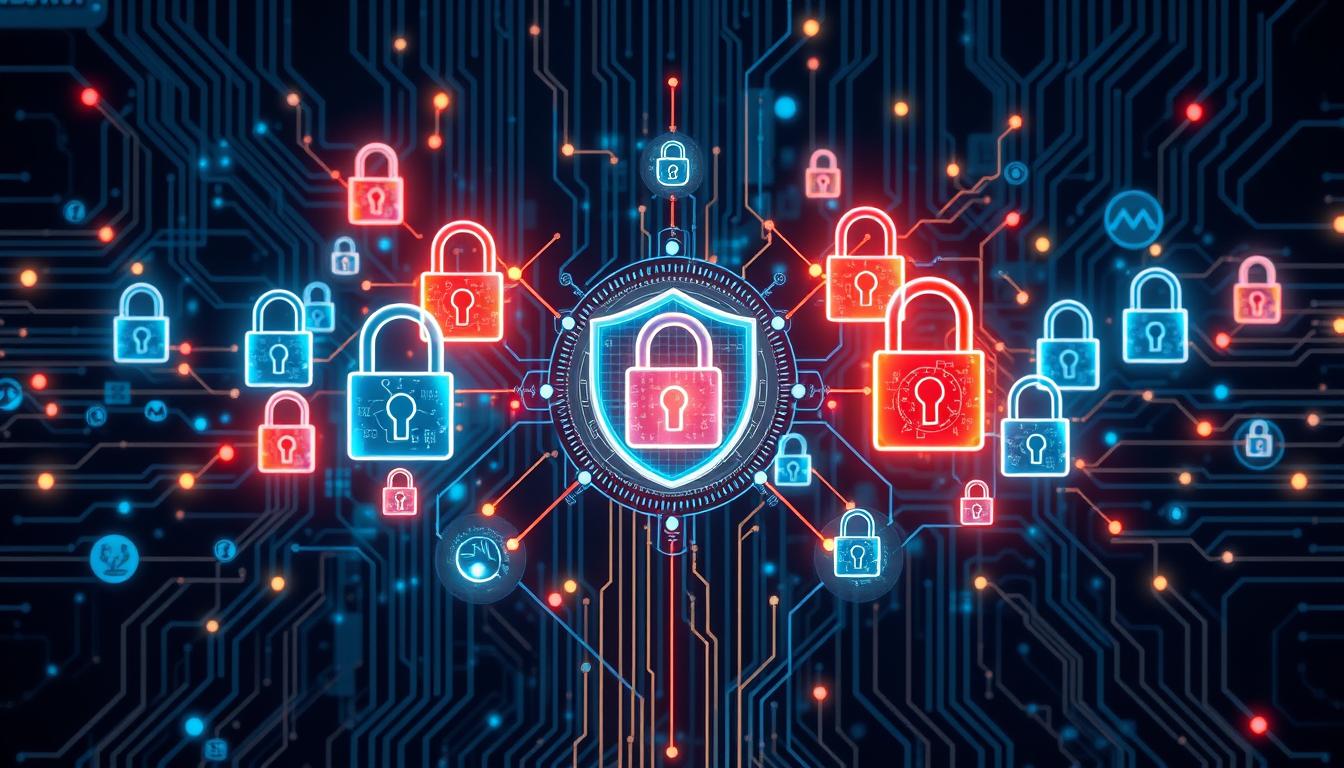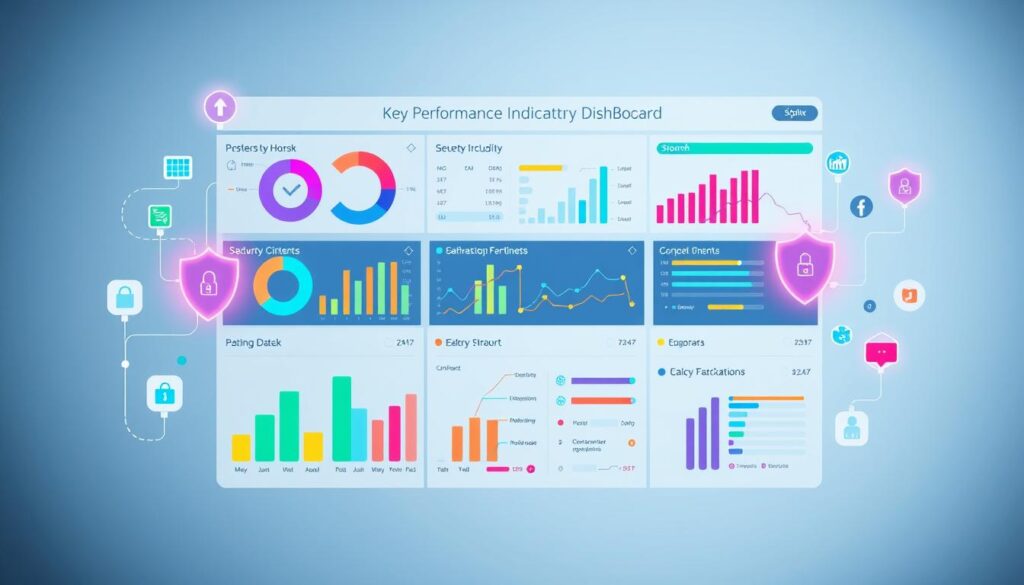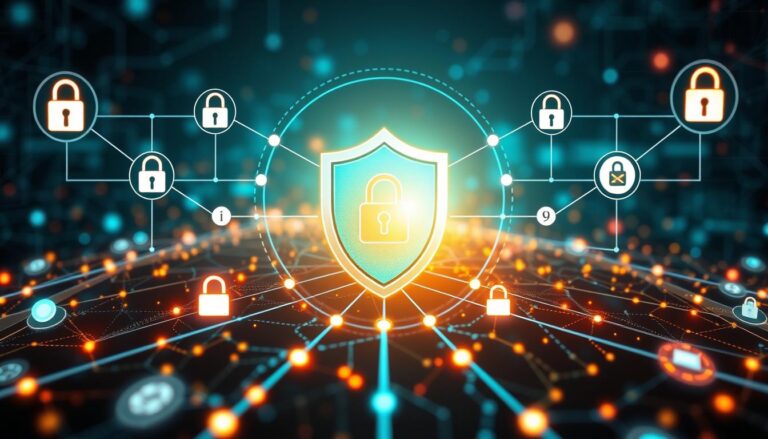
Did you know that about 70% of cyber attacks happen because of bad governance and poor risk management? In today’s world, where cybersecurity threats are growing, companies must focus on strong information security governance standards. These standards are key to a solid data protection framework. They help match security efforts with business goals and follow the law.
By using IT governance best practices, your company can better protect important data and build trust with others. This article will help you understand the details of information security governance. It shows why it’s so important and how to protect your company from cyber threats.
Introduction to Information Security Governance
Information security governance is key to good cybersecurity in companies. It sets up the rules and steps to keep data safe. This helps organizations protect their valuable information in today’s digital world.
Using the right governance frameworks helps improve security. The Cybersecurity Framework by NIST is a great example. It helps keep critical infrastructure safe. Companies that follow these standards are less likely to face security problems.
Companies today face big risks from unauthorized access and unclear roles. A strong governance framework is more important than ever. Keeping security measures up to date helps fight off threats. So, having good governance is vital for a safe business environment.
What are Information Security Governance Standards?
Effective information security governance is key for organizations to protect their data. It involves setting up policies, procedures, and controls to safeguard information assets. By working together, security leaders and stakeholders can manage risks well. This teamwork helps in creating governance structures that support business goals.
Definition of Information Security Governance
Information security governance is all about a structured approach. It guides decision-making and ensures it fits the organization’s risk appetite. This includes concerns about competitive advantage, regulatory compliance, and financial losses. Companies must follow both internal and external rules, like laws and industry standards.
Regular security checks are vital to ensure these standards are met. They are a key part of a strong governance framework.
Importance of Governance Standards in Cybersecurity
Governance standards are very important. They offer essential guidelines for setting up security controls. These controls help protect against data breaches and ensure compliance with rules.
Companies that follow standards like ISO 27001 show they are serious about information security. These frameworks not only reduce risks but also improve reputation and integrity. Not following these standards can lead to big penalties, legal issues, and damage to reputation.
Key Components of Information Security Governance
Creating a strong information security governance framework is key. It involves several important parts. These parts help make effective security policies and procedures. They also aid in managing risks and ensuring compliance.
Using the right risk assessment techniques is essential. This way, you can tackle the cybersecurity risks your organization faces.
Policies and Procedures
Your organization needs clear security policies. These policies guide how to manage information. They should cover data handling, access controls, and incident reporting.
It’s important to update these policies regularly. The world of cybersecurity is always changing. Without up-to-date policies, your organization is at risk. About 41% of organizations lack this critical framework.
When policies are tailored to your needs, they help meet regulatory requirements. This includes GDPR and HIPAA.
Risk Management Framework
A risk management framework is key for a proactive approach to threats. It involves identifying and assessing risks. This helps you use resources wisely and tailor your strategy.
It’s alarming that 47% of organizations don’t have a complete framework. A strong risk management foundation can greatly reduce security incidents.
Roles and Responsibilities
Clear roles in information security are vital for protecting your organization. They help avoid confusion and ensure everyone is accountable. Yet, 50% of organizations struggle to define these roles.
Working together in cybersecurity teams is important. It builds a strong security culture. Assigning specific roles improves incident response, as good communication is key.
| Component | Importance | Statistics |
|---|---|---|
| Policies and Procedures | Guidance for information management | 41% have formalized security policies |
| Risk Management Framework | Proactive threat identification | 47% lack a complete framework |
| Roles and Responsibilities | Clarifies accountability and engagement | 50% have not established clear roles |
Benefits of Implementing Information Security Governance Standards
Using information security governance standards helps organizations a lot. It makes protection of information assets better and boosts data security. It also helps in fighting off threats and makes sure security plans match business goals. Plus, it keeps the organization in line with laws and rules.
Enhanced Protection of Information Assets
Security governance makes a big difference in fighting cyber threats. Studies show that firms with strong governance can cut down security breaches by up to 70%. They also find about 90% of threats through regular checks, helping them keep data safe and reduce loss.
Improved Compliance with Regulations
Having a clear plan for information security helps follow rules like GDPR and HIPAA better. Firms that stick to these industry standards see a 30% drop in fines for data breaches. They also face a 60% lower chance of getting fined, which helps their reputation.
Better Risk Management and Incident Response
A solid security governance plan helps in managing risks and responding to incidents fast. Firms with good plans can recover from data breaches up to 70% faster. They also spot vulnerabilities 40% sooner, making them safer. This approach makes everyone in the company more aware of their role in keeping data safe.
| Benefit | Impact |
|---|---|
| Reduced Breaches | Up to 70% reduction in possible security breaches |
| Compliance Penalties | Up to 30% less in fines |
| Incident Recovery | Recovery time cut by up to 70% |
| Threat Identification | Finds up to 90% of threats with regular checks |
| Stakeholder Trust | Boosts stakeholder trust by 30% |
Challenges in Establishing Governance Standards
Setting up good information security governance standards is tough. It’s hard to balance security needs with business goals. You need to protect data without slowing down operations.
When business goals and security clash, it’s hard to manage. This can make governance tough. It’s important to find a balance that works for everyone.
Balancing Security and Business Objectives
Security and business goals often don’t match. Security steps needed for safety can block business plans. You need to find a way to make security fit with business goals.
It’s key to get everyone on the same page about cybersecurity. This helps everyone work together better.
Resource Allocation and Budget Constraints
Money and resources are often tight for security. Companies have to choose where to spend on cybersecurity. They also have many other important things to do.
It’s important to spend on the right things to keep information safe. This is key for good governance.
Evolving Cyber Threats
The world of cyber threats is always changing. New ways to attack and vulnerabilities pop up all the time. This makes it hard for companies to stay safe.
Keeping up with these threats means always updating and training. A watchful culture in your company helps fight off new threats. This shows the need for flexible governance.
| Challenge | Description | Impact on Governance |
|---|---|---|
| Balancing Security and Business Objectives | Conflicts between security measures and business goals. | Can lead to ineffective risk management and compliance. |
| Resource Allocation and Budget Constraints | Limited budgets often restrict necessary cybersecurity funding. | Impacts the ability to implement critical security controls. |
| Evolving Cyber Threats | Constantly changing tactics by cybercriminals. | Requires continual adaptation of security measures and governance frameworks. |
Understanding the Importance of Cybersecurity Compliance Regulations
Today, companies face many challenges in keeping their cybersecurity strong and following important rules. It’s key to know how these rules guide your cybersecurity plans. This helps protect sensitive info and keeps customers and stakeholders trusting you.
Major Regulatory Frameworks
Following big rules like GDPR, HIPAA, and PCI DSS is vital for keeping data safe. These rules set out regulatory compliance measures to protect data’s confidentiality, integrity, and availability (CIA). Here are some major rules you should know:
- GDPR: It makes sure companies are clear about how they collect data and gives people control over their data. Not following it can lead to fines up to €20 million or 4% of global sales.
- HIPAA: It’s for healthcare providers and makes sure health info is kept safe and shared only with consent. Not following it can lead to legal trouble.
- PCI DSS: It requires companies handling credit card info to check their compliance every year. Not following it can mean not being able to accept credit cards and big fines, like in the TJX Companies data breach.
- SOC 2: It focuses on trust service principles like safety and privacy. These are key for building customer trust and loyalty.
Impact of Non-compliance on Organizations
Companies that ignore cybersecurity rules face big problems. The effects of not following rules can be severe, including:
- Legal Repercussions: Authorities might start investigations, leading to big fines and even criminal charges.
- Organizational Risks: Not following rules makes companies more vulnerable to cyber attacks, which is a big risk for small businesses.
- Financial Costs: Data breaches can cause long-term financial damage, like legal fees, recovery costs, and losing customer trust. The IBM Cost of a Data Breach Report 2023 says average fines can be about $40,000.
- Reputational Damage: Losing trust can make customers leave, leading to less revenue and harm to your company’s reputation.

Creating a strong cybersecurity compliance plan is essential. It helps meet rules and avoid the bad effects of not following them. The world of cybersecurity keeps changing, so staying alert and adapting is key to keeping your organization safe.
Best Practices for Information Security Governance Implementation
To make your organization’s information security better, following best practices is key. These include regular risk checks, good policy making, and training for employees. They help build a strong security base for your company.
Regular Risk Assessments
Regular risk checks help spot possible weak spots. Over 68% of companies that do this feel more secure. It’s a smart way to find and fix problems before they happen.
Effective Security Policy Implementation
Having good security policies is vital. When everyone knows and follows these rules, your company stays safe. Companies with clear policies see a 30% drop in security problems.
Training and Awareness Programs
Creating a culture of security needs good training. About 70% of security issues come from mistakes people make. Teaching employees about cybersecurity helps them protect your company’s data.
Monitoring and Evaluating Security Governance Performance
Monitoring and evaluating security governance is key for organizations. It helps them match their security efforts with business goals. By setting KPIs, they can measure the value of their security work. This helps in improving governance and performance.
Setting Key Performance Indicators (KPIs)
Creating KPIs helps organizations measure their security work. A big 91% of senior management needs KPIs to check security programs. But, 70% struggle to link security metrics with business goals.
This gap can make security investments seem less valuable. Good KPIs might include:
- Mean Time to Detect (MTTD)
- Incident Prevention Ratio
- Average Cost of Security Breaches
- Protection Capacity Index (PCI)
Good KPIs show how well security is doing and how it reduces risks. Metrics like Total Cost of Ownership (TCO) and Economic Value Added (EVA) help see the financial side of security. This leads to better strategic decisions.
Conducting Information Security Audits
Regular security audits are vital for checking if governance standards are followed. These audits check if security controls are working right. Over 50% of organizations don’t have a standard way to measure performance, making security checks harder.
When doing audits, consider these:
| Audit Type | Description | Frequency |
|---|---|---|
| Compliance Checks | Ensure adherence to internal and external standards. | Quarterly |
| Risk Assessment Reviews | Identify and evaluate possible vulnerabilities. | Annually |
| Incident Response Testing | Simulate breach scenarios to check readiness. | Bi-Annual |
Good security audits give insights into an organization’s security. They show where to improve. This ongoing process boosts standard adherence and builds a culture of responsibility.

Information Security Governance Standards in Practice
Looking at case studies of companies that have done well with information security governance standards is very helpful. These stories show how following specific governance plans can really improve security and encourage following the rules. It’s key to know both the successes and mistakes in governance to help your company.
Case Studies of Successful Implementations
Many companies from different fields have shown how good information security governance works. For instance, ISO/IEC 27001 certification shows a company’s strong commitment to managing information security. With over 41,000 organizations certified by 2023, it’s clear this standard is effective.
Healthcare providers, with 1.8 million HIPAA compliant, highlight the need to protect health information online. Companies using the NIST Cybersecurity Framework show how to manage cybersecurity risks well. This framework is used by over 30% of U.S. organizations, showing it’s a good choice.
Common Pitfalls to Avoid
Even with successes, companies often face challenges in implementing governance. Mistakes like not doing thorough risk assessments can leave big holes in security. Also, unclear policies can confuse employees, making it hard to meet security goals.
- Inadequate Risk Assessments: Not doing good risk checks can put companies at big risks.
- Unclear Policies: Bad policies can confuse employees, making it hard to follow rules.
- Lack of Employee Training: Without training, staff might not understand the importance of security.
Fixing these problems can make your information security governance better. This helps your company stay safe from threats.
| Standard | Organizations Affected | Adoption Rate |
|---|---|---|
| ISO/IEC 27001 | 41,000+ | Widespread compliance focus |
| HIPAA | 1.8 million | Healthcare providers and plans |
| NIST Cybersecurity Framework | 30% of U.S. organizations | Voluntary adoption for risk management |
| ISO 22301 | 1,300+ | Global certifications issued |
Looking at these case studies and common mistakes helps a lot. It gives you important tips to improve your company’s information security governance. By learning from others, you can make your company better at following rules and managing risks.
Future Trends in Information Security Governance
The world of information security governance is changing fast. New technologies like AI and IoT are coming up. These changes mean organizations need to update their security plans.
Adapting to these new technologies is key. It helps your organization stay safe and follow new rules. This way, you’re ready for future risks and keep up with changing laws.
Emerging Technologies and Their Impact
New tech changes how we handle information security. Using AI and automation helps manage risks better. But, it also brings new dangers.
Cyber threats, like ransomware, are getting more complex. Over 300% more attacks have happened. This shows how important it is to update security plans and follow new rules.
Shifts in Compliance Expectations
Rules for keeping data safe are always changing. It’s important for companies to keep up. Not following these rules can cost a lot, over $1.5 billion in recent years.
Ignoring cyber security can cost even more, up to $10.5 trillion by 2025. Staying flexible with your security plans is key to protecting your data.
| Trend | Impact | Action Required |
|---|---|---|
| AI and Machine Learning | Enhances security measures but introduces new vulnerabilities | Integrate AI tools for improved compliance monitoring |
| Increased Compliance Regulations | Complexity in adhering to diverse legal frameworks | Regularly update governance strategies to align with regulations |
| Rise of IoT Devices | Leads to more attack vectors and vulnerabilities | Implement strict security protocols for connected devices |
| Shift towards Automation | Streamlines security processes and reduces human error | Invest in automation tools for efficient risk management |
Conclusion
Setting up and using information security governance standards is key today. Over 80% of companies struggle to understand their roles in this area. This shows how vital information security governance is.
By having clear rules and expectations, companies can lower their risks. They can also improve how well they follow rules and strengthen their cybersecurity. This makes their digital world safer.
Companies that use good governance well can cut their data breaches by 30%. This shows how important it is to have a strong plan. Also, research finds that strong security plans help companies respond to threats 50% faster.
As cyber threats grow, having a solid governance framework is more important than ever. It not only keeps your assets safe but also boosts your company’s image. It helps build trust with your customers.
In short, using good governance that matches your business goals has many benefits. It helps your company deal with cybersecurity challenges confidently. By focusing on training and managing risks, you can face future challenges head-on. You’ll also enjoy the many perks of a solid governance structure.
Source Links
- Understanding information security governance
- A Guide to Information Security Governance
- Information Security Governance – ERMProtect Cybersecurity
- Overview: What is a Security Governance Framework | Gutsy
- What is Information Security Governance ?
- How Security Governance Can Help Protect You from Cyberthreats
- ISO/IEC 27014 Information Security Governance
- What Are Information Security Standards? | RiskXchange
- Information Security Governance Framework Guide for IT Activities
- What are the key components of a security governance framework?
- What Is Information Security Governance?
- Unlocking the Benefits of Information Security Governance and Risk Management
- Security Governance: Understanding, implementation, and best practices
- Governance of Information Security
- Cybersecurity Governance, Part 1: 5 Fundamental Challenges
- What Is Cybersecurity Compliance | CompTIA
- Cybersecurity compliance: What you need to know
- Compliance
- How To Implement A Successful Information Security Governance Program? –
- IT Governance Framework: Overview & Best Practices | ConnectWise
- Cybersecurity Governance | CISA
- Key Performance Indicators for Security Governance, Part 1
- 22 Cybersecurity Metrics & KPIs to Track in 2024
- Cybersecurity Standards and Frameworks | IT Governance USA
- Information Security Governance: Framework for IT Compliance
- 20 Emerging Cybersecurity Trends to Watch Out in 2025
- The Future Cybersecurity Compliance Trends That Will Shape Your Strategy | Microminder Cybersecurity | Holistic Cybersecurity Services
- Information Security Governance Roles and Responsibilities
- Information Security Governance vs Information Security Management
- Top 10 IT Security Frameworks and Standards Explained!



